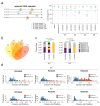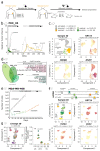H3K27me3 conditions chemotolerance in triple-negative breast cancer
- PMID: 35410383
- PMCID: PMC7612638
- DOI: 10.1038/s41588-022-01047-6
H3K27me3 conditions chemotolerance in triple-negative breast cancer
Abstract
The persistence of cancer cells resistant to therapy remains a major clinical challenge. In triple-negative breast cancer, resistance to chemotherapy results in the highest recurrence risk among breast cancer subtypes. The drug-tolerant state seems largely defined by nongenetic features, but the underlying mechanisms are poorly understood. Here, by monitoring epigenomes, transcriptomes and lineages with single-cell resolution, we show that the repressive histone mark H3K27me3 (trimethylation of histone H3 at lysine 27) regulates cell fate at the onset of chemotherapy. We report that a persister expression program is primed with both H3K4me3 (trimethylation of histone H3 at lysine 4) and H3K27me3 in unchallenged cells, with H3K27me3 being the lock to its transcriptional activation. We further demonstrate that depleting H3K27me3 enhances the potential of cancer cells to tolerate chemotherapy. Conversely, preventing H3K27me3 demethylation simultaneously to chemotherapy inhibits the transition to a drug-tolerant state, and delays tumor recurrence in vivo. Our results highlight how chromatin landscapes shape the potential of cancer cells to respond to initial therapy.
© 2022. The Author(s), under exclusive licence to Springer Nature America, Inc.
Conflict of interest statement
C.V. is founder and equity holder of One Biosciences. The remaining authors declare no competing interests.
Figures














References
-
- Vallette FM, et al. Dormant, quiescent, tolerant and persister cells: Four synonyms for the same target in cancer. Biochemical Pharmacology. 2019;162:169–176. - PubMed
-
- Shen S, Vagner S, Robert C. Persistent Cancer Cells: The Deadly Survivors. Cell. 2020;183:860–874. - PubMed
-
- Cortazar P, et al. Pathological complete response and long-term clinical benefit in breast cancer: the CTNeoBC pooled analysis. The Lancet. 2014;384:164–172. - PubMed
Publication types
MeSH terms
Substances
Grants and funding
LinkOut - more resources
Full Text Sources
Other Literature Sources
Molecular Biology Databases

